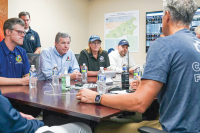All about the water: Adults get creek-splashing in inaugural waterways education event
 There’s excitement in the air as the class, its members scattered across the Pigeon River under cloudy skies in Canton, hunches over the water in an enthusiastic search. Slightly encumbered by awkwardly bulging, oversize wader suits, class members turn over rocks, shuffle their feet across the river bottom and generally stir things up to flush any nearby aquatic creatures into their waiting nets.
There’s excitement in the air as the class, its members scattered across the Pigeon River under cloudy skies in Canton, hunches over the water in an enthusiastic search. Slightly encumbered by awkwardly bulging, oversize wader suits, class members turn over rocks, shuffle their feet across the river bottom and generally stir things up to flush any nearby aquatic creatures into their waiting nets.
Haywood Waterways Association has provided this education program year after year for eighth-graders in Haywood County, but on Sept. 24, the class wasn’t composed of over-energetic teenagers.
Mountains to Sea: The quest for fresh seafood
 Debbie Milner has a simple philosophy.
Debbie Milner has a simple philosophy.
“If I won’t eat it, I won’t sell it,” she said.
Standing next to a large display case at Sentelle’s Seafood in downtown Clyde, Milner points out all of the right-off-the-boat and shipped to Southern Appalachia products her family business offers.
Tracking the sicklefin: Understanding rare fish’s lifestyle important for conservation
 The sicklefin redhorse is a sneaky kind of fish. It wasn’t discovered as a species until 1992, and even with its existence known, the fish is difficult to tag and track, avoiding radio detection at the bottom of deep river pools. But will the bottom-feeding suckerfish also be able to avoid getting listed as a threatened or endangered species?
The sicklefin redhorse is a sneaky kind of fish. It wasn’t discovered as a species until 1992, and even with its existence known, the fish is difficult to tag and track, avoiding radio detection at the bottom of deep river pools. But will the bottom-feeding suckerfish also be able to avoid getting listed as a threatened or endangered species?
Mike LaVoie, biologist for the Eastern Band of Cherokee Indians, is hoping to answer that question with a negative. The sicklefin has been a candidate for listing since the early 2000s — candidate species are those for whom listing is recommended but funds aren’t available to follow through — but it’s likely the U.S. Fish and Wildlife Service will make a decision by the end of 2015. Listing can help vulnerable species make a comeback, but it can also make things more difficult for people who use the river.
Have you seen this fish? Researchers probe new species called the sicklefin redhorse
When Dr. Robert Jenkins proclaimed in 1992 that he had discovered a new fish species in the Hiwasee and Little Tennessee rivers, it likely caused a stir among ichthyologists who found their library of fish field guides suddenly out of date and a handful of museum curators who scrambled to correct their collections.









